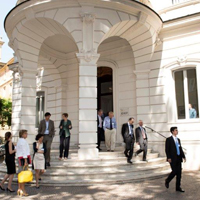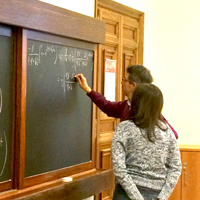Highlights 2025
WP 25/13
In “Optimal Redistribution with Government Debt” Facundo Piguillem and Kirill Shakhnov study the interplay between government debt and redistribution, they do so in an Overlapping Generations Economies (OLG) with heterogeneous agents. The government uses capital and progressive labor taxes for spending, debt, and income redistribution. They show that increasing inequality leads to more progressivity and also higher government debt. They further explore how borrowing limits hinder the government’s ability to redistribute income. Calibrating the model to the U.S. (2000-10), they estimate that the optimal debt level should roughly double to respond to rising inequality.
WP 25/12
In “Hyperbolic Discounting with Random Gratification” Facundo Piguillem and Liyan Shi analyze the link between quasi-hyperbolic discounting and optimistic expectations. They study the dynamic problem of decision makers with quasi-hyperbolic discounting and random shocks to temptation. They show that the problem is equivalent to that of a standard consumer-saver who assigns biased weights to future shocks. If the weights constitute a probability measure, the decision maker can be interpreted as optimistically biased, ensuring a unique equilibrium with continuous decision rules and implying no value for commitment devices. Otherwise, there is intertemporal "conflict'' between present and future selves: if the conflict is limited, uniqueness is guaranteed.
WP 25/11
In “Fiscal Rules and Discretion with Risk of Default” Chiara Felli, Facundo Piguillem and Liyan Shi study optimal fiscal rules when present-biased governments can default on their debt. Beyond their tendency to overaccumulate debt, governments exhibit biases in default incentives. Depending on the severity of the bias and the cost of default, governments may either over-default, inefficiently defaulting at low debt, or under-default, retaining excessively high debt. The latter arises from a “clean-slate externality”: governments fail to internalize the future benefits of offloading debt. They show that balancing the commitment to not overspend with the flexibility to react to shocks, it is optimal to complement spending rules with default rules that either forbid or force default.
WP 25/10
In “Fiscal Unions with Present Biased Governments” Jacopo Orlandi and Facundo Piguillem analyze the optimal design of a fiscal union when the member governments tend to over accumulate debt. They consider an environment where present-biased governments must insure against future shocks. The present bias generates a reason for fiscal rules to exist, while risk sharing motives bring out the need for transfers. A central authority designs the optimal combination of state contingent transfers and fiscal rules that maximize the federation’s welfare. They show that independently of the present bias, it is optimal to achieve the first-best pattern of aggregate spending. However, how it is implemented depends on the intensity of the bias. When the bias is mild, a mechanism akin to an emergency fund with tight fiscal rules arises, while when the bias is severe, it is optimal to provide loans with contingent payments and to loosen up fiscal rules. Moreover, there is always a degree of bias for which a fiscal union is not optimal.
WP 25/09
In "The Economic Consequences of War", Joao Monteiro, together with Efraim Benmelech, provide systematic evidence on the macroeconomic consequences of war using a new dataset covering 115 conflicts and 145 countries over the past 75 years. They document three main findings. First, conflict generates large and persistent real effects: real GDP falls by 13% on average, with no recovery even after a decade, while investment collapses as financial frictions reduce domestic credit. The drop in real activity is more pronounced for intrastate conflicts than it is for interstate conflicts. Second, government finances deteriorate as revenues contract and expenditures remain stable, thus raising primary deficits. Real government debt also declines, and governments shift 1.2% of GDP toward short maturities. Third, governments rely heavily on inflation to finance their deficits: the price level and money supply both rise by nearly 50%, eroding debt and generating seigniorage but also depressing investment and raising the cost of imported capital goods.
WP 25/08
In “Empowerment or Indoctrination? Female Training Programs under Dictatorship”, Mounu Prem together with Felipe González and Cristine von Dessauer study how autocrats often control social organizations to spread their ideology. In particular, they examine the Pinochet dictatorship in Chile (1973–1990), where conservative military forces controlled female social organizations to promote traditional roles for women as mothers and housewives. Partnering with higher education institutions, the dictatorship delivered training programs aimed at fostering domestic skills. Their findings reveal these programs facilitated women’s entry into the labor market without changing their political views. Decades later, these programs are still linked to higher female labor force participation among women directly exposed during the dictatorship and their daughters raised in democracy.
WP 25/07
In "Military Spending and War" Joao Monteiro, together with Efraim Benmelech, revisit the theory of critical deterrence—the idea that military spending may reduce the risk of conflict by increasing its expected costs. To test this theory, they assemble a new cross-national dataset combining information on armed conflicts and defense spending over a 75-year period. They find that increases in military spending have no effect on short-run conflict risk—contrary to concerns that buildups may provoke escalation—but that they do lead to a small and persistent decline in conflict over the long run. Although the effect of spending on conflict is modest, its effect on the cost of war is large: higher military spending raises the scale of battlefield casualties. The effect of military spending on conflict is more pronounced for democracies, which are less likely to use force offensively, and is concentrated in internal conflicts involving nonstate actors. Last, the deterrent power of military spending is strongest in ethnically polarized societies—precisely where the threat of civil war is most acute. Their findings suggest a low pass-through from the cost of war to the incidence of conflict: even large increases in military spending produce only modest reductions in conflict risk, despite sharply raising the expected cost of war.
WP 25/06
In “The Economic Costs of Ambiguous Laws”, Luigi Guiso and Claudio Michelacci, together with Tommaso Giommoni and Massimo Morelli, use the full corpus of Italian legislation to measure the economic costs of poorly drafted laws, a potential threat to the rule of law. Using text-based analysis, they show that legal uncertainty—measured by the probability of disagreement between the Supreme Court of Cassation and lower courts—is higher for cases involving poorly written laws and varies systematically across courts. This legal uncertainty discourages firm growth and leads to higher business exit rates. The authors estimate that if all Italian laws were drafted with the same clarity as the fundamental principles of the Italian Constitution, GDP per capita in Italy could be around 5 percent higher. Roughly two-thirds of these losses have materialized over the past two decades, reflecting a progressive deterioration in the drafting quality of Italian laws.
WP 25/05
Labor income risk arises from potential job loss or wage volatility that can impact workers' earnings. This risk is particularly significant due to labor market frictions, which often lead to lasting negative effects for displaced workers. These frictions also make it difficult and costly for employees to switch jobs after a pay cut, giving firms substantial power in setting wages. As a result, firms can provide a form of implicit insurance by absorbing economic shocks themselves rather than passing them on to workers through layoffs or wage reductions. This paper, “Entrepreneurs’ Diversification and Labor Income Risk”, authored by Marco Pagano together with Jan Bena, Andrew Ellul, and Valentina Rutigliano, is the first to investigate whether entrepreneurs' ability to bear risk—thanks to portfolio diversification—enhances labor income insurance for employees in closely held firms. Using Canadian administrative data on over 524,000 firms and 858,000 owners, the study finds that entrepreneurs with more diversified portfolios do, in fact, offer better protection against labor income risk. Their firms provide greater job security and more stable wages. In particular, when owners’ portfolios are one standard deviation more diversified, the sensitivity of layoffs and earnings to foreign sales shocks drops by 13% and 41%, respectively. These entrepreneurs tend to reduce their own pay and increase firm leverage to fund this insurance. The improved protection is positively correlated with better retention of skilled workers and fewer costly separations, as well as improved firm profitability.
WP 25/04
In “Women Behind Bars: Do Single-Gender Prisons Reduce Recidivism?”, Daniele Terlizzese, together with F. Calamunci, G. Daniele and G. Mastrobuoni, study whether serving a sentence in a prison housing only women, rather than in the separate women section in a prison housing predominantly men, reduces women recidivism. They find that it does, by up to 16 p.p. While the precise mechanism is difficult to identify, the design and organization of correctional facilities customized around women needs and fostering rehabilitation initiatives specifically targeted at women inmates seem to require a minimum scale and an appropriately attuned sensibility.
WP 25/03
In “Math Exposure and University Performance: Causal Evidence from Twins”, Graziella Bertocchi, together with Luca Bonacini, Majlinda Joxhe and Giuseppe Pignataro, investigate the impact of exposure to math in high school on college major choice and academic performance, using a dataset of twins drawn from the student population of an Italian university. Their empirical approach accounts for confounding factors, such as family background, that would otherwise bias their results. They find that attending a low-math high school decreases the likelihood of choosing a STEM major, while it boosts academic performance in terms of on-time graduation and grades. A national high school reform that increased math hours in low-math curricula further reduced STEM enrollment but was the driver of the improvement in performance for treated students. Hence, more math does not increase STEM enrollment, but does provide students valuable skills.
WP 25/02
In "Does Distance Still Matter? Evidence from 30 Years of Mortgage Lending" Joao Monteiro, together with Menaka Hampole and Adam Jorring, study the role distance between lenders and borrowers plays in mortgage contracts. The find that mortgage lending by banks is still predominantly a local business. Local branches have a significant advantage in attracting and originating mortgages. More than 25% of borrowers are less than two miles from their branch, and more than 50\% are within 10 miles. Distance is associated with lower credit quality, and the additional risk is priced: higher distance is associated with a lower probability of approval, a higher interest rate spread, and a higher ex-post likelihood of delinquency. They document business cycle patterns as the distance rises in booms and falls in busts but find that the sensitivity of distance for loan approval and pricing has persisted over the past 30 years despite the dramatic rise in securitization and online banking. Using a quantitative spatial model of the mortgage market, they explore the economic mechanisms driving our results. Through the lens of the model, they find that decreasing search costs lowers the match quality of borrower search, which counteracts the effects of increasing screening technology. Their findings highlight that local bank branches are still highly relevant despite the "fintech" revolution.
WP 25/01
In "Government Support in Times of Crisis: Transfers and the Road to Socialism" Mounu Prem, together with Felipe González, explore the fact that despite economic crises, incumbents often retain electoral support. In particular, they study Chile’s 1970-1973 infant nutrition program under Salvador Allende’s left-wing government and attribute this electoral resilience to the political returns of transfers during crises. The program provided milk to preschoolers, reducing infant mortality and bolstering electoral support despite hyperinflation and economic hardship. Using administrative data, surveys, and variation in crisis severity, they show transfers had greater political returns in areas most affected by the crisis. Survey evidence suggests voters swayed by transfers did not blame the government for the crisis. Their findings highlight how transfers and crisis perceptions sustain electoral popularity.





